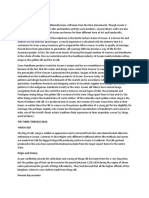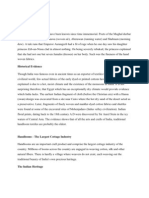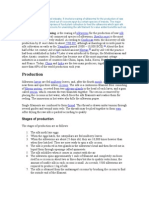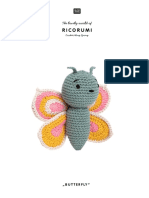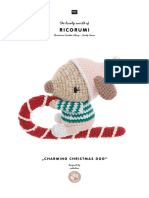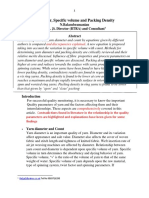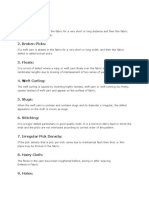Muga Silk
Muga Silk
Uploaded by
rupalisingh_fCopyright:
Available Formats
Muga Silk
Muga Silk
Uploaded by
rupalisingh_fOriginal Title
Copyright
Available Formats
Share this document
Did you find this document useful?
Is this content inappropriate?
Copyright:
Available Formats
Muga Silk
Muga Silk
Uploaded by
rupalisingh_fCopyright:
Available Formats
Silk Industry of Sualkuchi Assam has a rich legacy not only of great rulers, but of great artists an d craftsman.
The women of this state are born weaver from the ancient time. Sual kuchi bears the millennial heritage of Handloom Culture since long past. Patroni zed by the kings of Pals and Ahoms, weavers created dreams in Golden Silk (Muga) . During the 600 years of Ahom Kingdom, Muga Silk and Pat Silk was worn only by Ahom king and noble families of Assam. One can distinctly gear the rhythm of the shuttles of the looms as soon as one e nters Sualkuchi A craft Village popularly know as Manchester of the east . It is Sualkuchi the weaving art has been practiced since time immemorial. On 9th Janu ary, 1946, while Mahatma Gandhi visited Sualkuchi a weaver Late Rajin Deka creat ed. Mahatma Gandhi s Portrait in fabric in handloom. Gandhi enchanted by his creat ion. Gandhi remarked Every women of Assam is a born weaver. No Assamese girl who does not know to weave can expect to become a wife. And she weaves fairy tales i n cloth. Ex president, missile man Dr. APJ Abdul Kalam visited Sualkuchi on 17th October 2006 and mesmerized with the amazing beauty of magical cloth. Asia s largest silk village Sualkuchi and 95% of its population concerning to silk industry for earning. According to one current survey, everyday 17,000 weavers are engaged simultaneously in their looms for the Silk ware. Of these about 5000 0 people are employed directly or indirectly in the Silk Village. It is noted that from 1960 to 2002, during these 40 years the increasing rate of handloom in Sualkuchi per year is about 4%. It is a quite positive nature whene ver the traditional crafts are forgotten by the people of Assam, it is increased day by day. In 1939 there were 300 looms only but in 2006, it increased to 25,5 38 looms. The weavers produced the cloth using 0.5 million kg of silk thread eve ry year and the yearly turnover is rupees fifteen thousand million. 90% of the h ousehold in the village have looms. The weavers can earn money from 3000/- to 50 00/-. Economical Activities at a Glance Total family engaged in weaving 4478 Nos. Total Nos. of Loom 17000 Nos (approximate) Total Nos. of self employed weavers 4944 Nos. Total Nos of weavers employed 12056 Nos. Indirect employment generated 10000 Nos (Approximate) Yarn consumption yearly (Approximate) Mulberry silk 200000 kg Muqa silk 98000kq. Production of cloth 31 lathes linear meter (approximate) Value of finished products 90 cores (approximate) No. of members of Co-op. Society 21 Nos. No. of members of Co-op. Society 31.50 Nos. Export of products to other countries Rs.1200 lathes (approximate) (Source: Director, Handloom & Textile Dept Govt of Assam)
The Silk industry of Sualkuchi is spreading. In the basis of Sualkuchi Silk Indu stry,the Industry is extended to the neighboring area. A survey is occurred in t he help of NEDFI and TEDF, they noticed that the whole area turns into Sualkuchi Silk Industry Cluster and till 2002, 26058 looms were found only in the neighb oring area. There is a lot of potentiality in this Industry. It has ample opportunity to exp ort and also provide employment to a large numbers of rural populace. But the la ke of proper guidance, new technology, raw materials scarcity of market are the main problems faced by the Silk Industry. Govt. should do their best for preser vation and promotion of this timeless tradition through a series marketing schem es to gear up the glorious Industry. Muga Silk Mugahas been in Assam since the Vedic age. Kamrup king Bhagadatta fought the Kurukhetra war in apparel made of this golden silk. In Arthasastra of Kautilya, the golden cloth of Kamrup was mentioned. Muga is the golden fibre of Assam and which is not available anywhere else in the world. The North Eastern India alon e contributes 99% of the total production of Muga respectively in the country an d 955 of the total production produces in Assam. In Assam 6755 hectare land is u sed in cultivation of Muga and within 2006-07, the production was 107 m.t only i n Assam. In the end of 9th plan the production of Muga in Assam was 93 m.t. and in the end of 10th plan the production increased to 107 mt. Muga is obtained from semi domesticated silk worm called aantheraea asamenisis. som and soalu. Antheraea assamenisis are raised outdoors primarily on two trees Chemically Muga is made of proteins secreted in the fluid state by a caterpillar , popularly known as silkworm. These silkworms feed on the selected food plants and spin cocoons as a protective shell to perpetuate the life. Silk worms have f our stages viz. egg, caterpillar, pupa and moth. The caterpillars are placed on a tree and when they have stripped the tree of fo liage, the caterpillars will make a mass exit down the trunk. They are collected by the keepers and placed on another tree. When ready to their cocoons, these c aterpillars once again exit the tree where they were feeding. This behavior allo ws the keepers to collect and control the caterpillars. Each caterpillar is placed into a jail, a container made of dried twigs. The ped uncle (silk that anchors the cocoon) is very weak; the caterpillars prefer a low place with numerous twigs to protect them while in their cocoons. The silk is c alled Muga, the Assamese word for rich amber color of the cocoon. The Muga cocoo n has a very weak peduncle and is golden yellow. The cocoons are boiled in shop and soda solution and are reeled in reeling machine. Popularity of Muga fabrics is mainly because of the following qualities. Natural Golden Shade :Natural golden color of Muga is unique. There are hardly any fabrics with this natural shade. Unlike mulberry silk which is bleach ed and dried, Muga silk has the natural quality of appearing almost like spun go ld. Glossy : Besides the golden color, the Muga fabric is glossy. It makes the golden color more attractive both outside and inside use. Fine Texture : It is very difficult to find diverse qualities blended int o one yam. Lustrous texture is one of the various qualities found in muga fabric . Durability : Muga silk is also very durable. Articles of Muga clothing ha ve been known to last for 50 years. For 600 years Muga silk was worn only by Aho m king and noble families of Assam.
Generally made from Muga silk are mekhela sadar, riha, saree etc. Nowadays the f ashion has changed and with the change of trend it is used in making salwar, wal let, kurta, stylish jacket, neck tie and also dress materials for designers. In Japan Muga silk is used in manufacturing beautiful and stylish Japanese umbrella which is preferred all over the world. In Assam the Muga silk is cultivated mos tly in Dhemaji, Lakhimpur, Palashbari, Kokrajar, Goalpara, Sibsagar etc. It is n ot only eco-friendly but also provides employment to a large numbers of rural po pulace. Pat Silk India is the only country in the world which produce all the four commerc ially known varieties of silk namely Mulberry, Muga, Eri and Tasar. These variet ies of silk are broadly classified into two categories Mulberry and Non-Mulberry . Mulberry is cultivated in most part of the states. The entire North-Eastern re gion is renowned as one of the Ecological Hot Spots in the world. The climatic con dition prevailing in the entire region is suitable for commercial exploitation o f all four varieties of silks. Pat is a mulberry silk. It is produced from two types of worms Bar polu(Bombyx t extar) and Soru polu(bombyx croesi). Both types are reared inside and fed on the leaves of mulberry. When the worms growing up within the coccon, it is spun and turns into threads. Pat silk have their natural colour and it can tinge beautif ul colour. Assam has an important place in production of mulberry silk. 2500 hec tare area of Assam is cultivated mulberry silk and in 2006-07 it produced 11 met ric ton raw silk. The production of Mulberry raw silk in the end of 9th plan in Assam was 12 mt. and end of the 10th plan it decreased into 11 mt. Pat silk are the finer varieties of silk and a costly silk to afford for all peo ple. Qualities: Long lasting. Less wrinkle. It has a natural and different glaze. Generally the products of Pat silk are Mekhela-sadar, Riha, Gamosa, Dora sadar, Saree etc. Nowadays it change its traditional look into salwar, kurta, ghagra, l ehenga, baby dress, skirts and also dress material of designer. And also other c ommunities dress like Karbi s Packok, Boro s Dokhona and Langa etc. Sualkuchi is also known for its Pat silk. The Pat silk of Sualkuchi is preferred from the times of Ahom Kingdom till today. About 2,00,000 k.g Pat threads are u sed in manufacturing fabrics in Sualkuchi. The raw materials are mainly supplied from Karnataka and Tamilnadu. The weavers have generally become dependent on th e intermediaries thread suppliers. The thread merchants buy the threads from Chi na. There was steady and direct supply of threads from China and Japan to Sualku chi till 1963. 10,393 looms were engaged in producing Pat silk till 2003. Pat si lk is an essential part of marriage and use at the festivals to manifest social status. Initiatives taken to promote Handloom Sector Assam s legendary handloom, with exotic charm, rare beauty and fantastic size and shape, bear the testimony of the State colourful heritage millennium of culture. The Assam Govt. marketing Corporation Ltd. come into existence on the 16th Dec 19 59 and since its inception have been rendering service to the development, promo tion and preservation of this timeless tradition. The tradition of handloom silk still holes their own place in the world market. The Assam Science Council and Environmental Council have taken of the task of obtaining a patent for the Muga Silk. The regional Muga research Station, Boko established during the year 1982 is looking after the overall research and development in support of Muga Culture
in the region. In order to provide necessary technical support on post cocoon s ector Central Silk Board has established one demonstration cum technical service s centre (DCTSC) in the year 1995-96 at Sualkuchi. The Muga raw material bank (M RMB) was established by Central Silk Board (CSB) during the year 1980 at Sivsaga r and subsequently sub depot at Dhokuakhana and Sualkuchi were also established with an objective to prevent the exploitation of Muga growers from the middle ma n and to ensure fare economic price of Muga reeling cocoon. The Govt. of India a pproved programme for the development of sericulture in North-Eastern region dur ing 11th Plan 2007-08 and 2008-09. Through the Central Silk Board people can kno w about the new schemes. The catalytic development programme of the 11th Plan is unique and effective for transfer of technology in the field by the research In stitute. Through this programme, people of the Silk Village would be benefitted. In case of purchasing Reeling Machine, Spinning Machine, Jacquards and Dubby Ma chine, Computer aided textile designing, yarn dying machine etc. people would be getting under the scheme with 80% subsidy. The Central Silk Board (CSB) has cre ated a symbol which is named as Silk Mark for testing of purity of Silk Products. Regional development office (RDO) acts as a nodal Office for Silk Mark Organizat ion of India (SMOI) and creating awareness amongst the consumers and manufacture rs about Silk Mark. There have been some initiatives at the Govermental level through the Central Si lk Board, state directorate of Handlooms and Handicrafts etc. The North-Eastern Council implemented a project in 1987 for the weavers of Sualkuchi and surroundi ng areas. The project aimed at organizing poor weavers into SHGs for their empow erment and sustenance by providing the forward and backward linkages. National I nstitute of Fashion Technology (NIFT) is an institute under the Ministry of Text iles, also undertook a project in 2004 for up gradation of technical skills, cre ation of Common Facility Centre, product innovation, design improvement, develop ment of CAD centre, coordination of various training programmes for weavers of S ualkuchi and surrounding areas etc. Under this project, about a hundred SHGs ha ve been formed and they have been provided with subsidies, revolving fund and ba nk credit linkages. With the financial help of North-East Council project name Sualkuchi Prokolpa to p romote and expand handloom. To globalize the handloom, the Ministry of Handloom and Textile and 25 co-operative societies are doing their duties, yet there are lack of sufficient efforts to promote handloom. Raw Materials India is the only country in the world which produces all the four commercial ly known varieties of silk namely Mulberry, Muga, Eri and Tasar. These varieties are broadly classified into two categories viz Mulberry and Non Mulberry. The no rth eastern India alone contributes 99.9% and 98% of the total production of Mug a and Eri Raw Silk respectively in the country. Assam is the largest producer in the world of the Golden Coloured Muga Silk . Presently 9173 hectares of land is co vered with Muga Silk worm food plants in North-Eastern States and 6755 hectares of land is covered only in Assam. In the year 2006-07, the muga Silk production in Assam was 107 metric ton. At the end of 9th plan the production of Muga in As sam was 93 m.t, while it was increased to 107 m.t at the end of 10th plan. In case of Mulberry Silk Assam cultivate only 2500 hectares of land and the total production of raw Silk was only 11 m.t. in the year 2006-07. At t he end of IXth plan the production of Mulberry Silk in Assam was 12 m.t. while i t decreased to 11 m.t at the end of Xth plan. In Sualkuchi the raw materials of Mulberry Silk and other silks are basically supplied from Karnataka and Tamilnadu. The weavers have generally beco me dependent on the intermediary thread suppliers. The thread merchants buy the threads from China. There was steady and direct supply of threads from China and Japan to Sualkuchi till 1963. The raw materials for weaving Golden Silk Muga come
s from Dhemaji, Lakhimpur, Palashbari, Kokrajar, Chaigaon, Goalpara, Sibsagar an d many other places of Assam. The weavers produce the cloth using about 0.5 mill ion k.gs of raw silk every year. The production of raw silk being essentially an agro-based activity, is not only eco-friendly, but also provides employment to a large numbers of rural populace predominantly women who can play vital role in the production of raw silk. Weavers bear the tradition of weaving
Weaving is an ancient art practice in the state of Assam, which is world framed for its silk and silk weaving. The craft has been practiced since time im memorial. Knowledge of weaving was considered as a must for every Assamese girl and no girl was considered suitable for marriage unless she could acquire profic iency in the art of spinning and weaving. Sualkuchi, which is 32 k.ms from Guwah ati is the biggest centre of silk production and weaving in Assam. The weaving tradition in this village can be traced to the 11th cent ury when king Dharma Pala of the Pala dynasty, sponsored the craft and brought 2 6 weaving families from Tantikuchi to Sualkuchi. The village took the shape as a weaving village when Ahoms occupied Sualkuchi defeating the Mugals in the mid 1 7th Century. Seeing the handwork and designs, the Mughals had bought cloths from the village. The village produces over six millions meters of white and Golden Assam Silk indigenously called Pat and Muga. The weavers produced the cloth using 0.5 million k.gs of Silk thread every year and the yearly turn over is Rs. 15,000 million. According to a curre nt survey, everyday 17 thousand weavers are engaged simultaneously in their loom s for the silk ware. Of these, about 15,000 come from different areas of the Sta te and the rest are from neighboring areas. About 50,000 thousand people are emp loyed directly or indirectly in the silk village. The wages of the weavers have increased from Rs. 600/- to Rs. 1000/in 1981 to Rs. 1900/- to Rs. 2000/- in 1999 to Rs. 4000/- to Rs. 5000/- in 2006 . Sualkuchi is a place where the labours (weavers) are given monetary advance and normally booked for a year. The migrant weavers have also created the problems o f housing them. Majority of the factory owners have little space to provide shel ters to the weavers. So, most of the workers stay in some rented houses construc ted by some land lords for the purpose. The migration of female weavers is indic ating several aspects of socio-economic life of people. These weavers keep on c hanging factories in search of high wage. Life Style The living style of the weavers, who are engaged in handlooms as employee s are not so high but they have the capacity to earn high. They have the common facilities for living even some of them can effort facilities like TV, Gas, FM R adio, Electronic Fan and even mobile phones. They are conscious about dress, orn aments cosmetic products. They are also conscious about the education of their c hild. They send their child to Montessori, Anganwadi and Govt. School. Some of t hem, who can afford the cost, admit their child in private Schools. Govt. has al so taken some steps to help the weavers. A scheme of free health check-up and fr ee hospital cost for weavers was taken in the year 2007 under the Ministry of He alth. The college admission fees for the children of the poor weavers in Sualkuc hi have been provided from Govt. for last few years. Weavers organization is esta blished to solve the problems of the weavers. The migrant weavers mainly come from Bodo community as well as Assam ese and Karbi community. The great man of the 20th Century Mahatma Gandhi visite d Sualkuchi on 9th January 1946. His comments that the Weavers of Sualkuchi could portray dreams in their looms, still motivates the people of Sualkuchi. Implement and Process
Traditionally the weavers of Assam use the throw shuttle loom in the plan s, but in Sualkuchi flying Shuttle Looms are used by the weavers. From 1939 flyi ng shuttle loom has been used in Sualkuchi. The essential tools required from fl ying shuttle looms mainly are wooden frame, variety shuttle, machine (to make de sign), cards (required for making design) etc.The flying shuttle looms consist o f four posts which are fixed to the ground so as to make a rectangular shape. Th ese are join together at the top by cross beams. At the top, a machine is combin ed to the loom with two wooden beams. A flying shuttle is thrown through a shade . As soon as the shuttle is out of the set the weft threads are beaten to fall o f the cloth. The cards are made by hard paper. In a card, there are some holes i n different measurement. When cards connected with the machine the cylinder of t he machine moves on and some thread lifts automatically. Shuttle is thrown throu gh the threads and thus the design is made. This type of looms is of almost perm anent as it comparatively needs more space.
You might also like
- Gadwal SareesDocument131 pagesGadwal Sareessurbhimo83% (6)
- Assam SilkDocument4 pagesAssam SilkNeelima KhandelwalNo ratings yet
- SilkDocument28 pagesSilkMusharaf Momin0% (1)
- Assam Silk Sericulture PDFDocument5 pagesAssam Silk Sericulture PDFsocialomicsNo ratings yet
- Art and Design AstheticsDocument30 pagesArt and Design AstheticsNishant BhadaniNo ratings yet
- Perspectives On Silk Industry of IndiaDocument7 pagesPerspectives On Silk Industry of IndiaRSBALAKUMARNo ratings yet
- Project MMDocument17 pagesProject MMAmal Barman100% (2)
- Text Tribal Embroidery of IndiaDocument7 pagesText Tribal Embroidery of Indiamansiagrawal100% (1)
- SilkDocument7 pagesSilklakshaNo ratings yet
- Kehc 108Document14 pagesKehc 108Sumeet GuptaNo ratings yet
- Art and Craft of IndiaDocument8 pagesArt and Craft of Indiago2pakadeNo ratings yet
- Export Procedure For SILKDocument39 pagesExport Procedure For SILKNikhil KarangutkarNo ratings yet
- TussarDocument11 pagesTussarAnkit AkashNo ratings yet
- SericultureDocument25 pagesSericultureashokkumar06276No ratings yet
- Brown Minimalist Casual Fashion Collection PresentationDocument81 pagesBrown Minimalist Casual Fashion Collection Presentationanusha.vanka2002No ratings yet
- 7.sericulture at RSRSDocument22 pages7.sericulture at RSRSSamuel DavisNo ratings yet
- Operations Research ReportDocument30 pagesOperations Research ReportVenkatesh RajuNo ratings yet
- Different Varieties of SilkDocument2 pagesDifferent Varieties of Silktaranjeetsinghsaini03No ratings yet
- Problems and Prospects of Sericulture: "Master of Business Administration" Bangalore Central UniversityDocument39 pagesProblems and Prospects of Sericulture: "Master of Business Administration" Bangalore Central UniversityUday GowdaNo ratings yet
- Rearing TechnologyDocument142 pagesRearing TechnologyAdita AgarwalNo ratings yet
- SilkDocument21 pagesSilkSarah KhanNo ratings yet
- Project ReportDocument59 pagesProject ReportArun Payyavoor100% (2)
- XIplanch 12Document60 pagesXIplanch 12Ridhima SinhaNo ratings yet
- ClusterDocument44 pagesClusteranulika dubeyNo ratings yet
- 1111032743BR15103CR15Sericulture and Sericulture Industry in Indiasericulture and Sericulture Industry in IndiaDocument17 pages1111032743BR15103CR15Sericulture and Sericulture Industry in Indiasericulture and Sericulture Industry in IndiaAkshat sharmaNo ratings yet
- IndustriesDocument96 pagesIndustriesdsethiaimtnNo ratings yet
- The Best All-Season Natural Silks of India: Presented byDocument22 pagesThe Best All-Season Natural Silks of India: Presented byShubhi SethiNo ratings yet
- Kishtwari LoieDocument16 pagesKishtwari LoieadhandloomkishtwarNo ratings yet
- Unit 1 PDFDocument15 pagesUnit 1 PDFBushu KhanNo ratings yet
- WeavingDocument20 pagesWeavingpapiraniNo ratings yet
- Ikat - Sambhalpuri and Bomkai WeaveDocument14 pagesIkat - Sambhalpuri and Bomkai WeaveAmarendra AgrawallaNo ratings yet
- Report On KashmirDocument20 pagesReport On KashmirAshfa IslamNo ratings yet
- HOF 1styear JamukashmirDocument13 pagesHOF 1styear Jamukashmirshivika dhananiNo ratings yet
- Literature ReviewDocument13 pagesLiterature ReviewDeepika SamyNo ratings yet
- Rajshahi SilkDocument10 pagesRajshahi SilkRidwan KabirNo ratings yet
- NamdaDocument3 pagesNamdaJanNo ratings yet
- "An Overview of Tasar Silk in India": Minor Project ONDocument24 pages"An Overview of Tasar Silk in India": Minor Project ONgarismritiNo ratings yet
- Market Statistics Report11Document9 pagesMarket Statistics Report11Pooja PatelNo ratings yet
- Internship Report On KsicDocument63 pagesInternship Report On Ksicvinodksrini007100% (6)
- The Traditional Epic Art of Bangladesh Intangible Cultural Heritage of HumanityDocument11 pagesThe Traditional Epic Art of Bangladesh Intangible Cultural Heritage of HumanityKalipada SenNo ratings yet
- Silk IndustryDocument12 pagesSilk Industryzeeshanrahman306No ratings yet
- SericultureDocument18 pagesSericultureSyed Mohd Hasan100% (1)
- Sericulture - FormattedDocument18 pagesSericulture - FormattedllldNo ratings yet
- Sericulture TechniqueDocument4 pagesSericulture Techniqueshaad788No ratings yet
- Lecture Sericulture: Related Terminologies, History and Development of Silkworms in India, Types of Silkworm, Voltinism and Biology of SilkwormDocument20 pagesLecture Sericulture: Related Terminologies, History and Development of Silkworms in India, Types of Silkworm, Voltinism and Biology of SilkwormVIVEK SUTARNo ratings yet
- Guwahati: A Dazzling Traditional Dress (Mekhela Chadar) Woven With 'Muga' Silk IsDocument5 pagesGuwahati: A Dazzling Traditional Dress (Mekhela Chadar) Woven With 'Muga' Silk Isritu1288No ratings yet
- Seri CultureDocument37 pagesSeri Cultureaditya bunkarNo ratings yet
- Review of Silk Handloom Weaving in AssamDocument12 pagesReview of Silk Handloom Weaving in AssamPallab jyoti GogoiNo ratings yet
- The Tale of Textile From Indus Valley CivilizationDocument2 pagesThe Tale of Textile From Indus Valley CivilizationKausar Iqbal0% (1)
- Sericulture 1Document67 pagesSericulture 1Depun MohapatraNo ratings yet
- SilkDocument15 pagesSilkyasirisNo ratings yet
- Muslin FabricDocument14 pagesMuslin FabricAshik Faisal89% (9)
- SILKDocument7 pagesSILKDivyanshi PrajapatiNo ratings yet
- Tradition Mising Weaving CraftDocument4 pagesTradition Mising Weaving CraftLee DarciaNo ratings yet
- Textile DesignsDocument34 pagesTextile DesignsKoshalNo ratings yet
- 802 - Unit 2Document79 pages802 - Unit 2shivii.2526singhNo ratings yet
- English Project QuestionsDocument3 pagesEnglish Project Questionsharshitachhabria18No ratings yet
- Spinning, Dyeing and Weaving: Essential Guide for BeginnersFrom EverandSpinning, Dyeing and Weaving: Essential Guide for BeginnersRating: 4 out of 5 stars4/5 (5)
- Summer CottageDocument27 pagesSummer CottageMelanie ManriquezNo ratings yet
- Vikash 1Document10 pagesVikash 1Archana RawatNo ratings yet
- Report On Bhagalpur Silk Industry April 2019Document10 pagesReport On Bhagalpur Silk Industry April 2019cleopatramonroe1No ratings yet
- Marcadores de Libro-1Document13 pagesMarcadores de Libro-1yahi2929No ratings yet
- Chapter 9 - Textile ArtDocument9 pagesChapter 9 - Textile Artklause Salaman100% (1)
- Kids Overall Kik-P107953Document1 pageKids Overall Kik-P107953IE DEPARTMENTNo ratings yet
- Revision Question Bank 1 Subject: Science Answer Scheme Grade: VIDocument6 pagesRevision Question Bank 1 Subject: Science Answer Scheme Grade: VIAayush KumarNo ratings yet
- Blend Dyeing (NEW BOOK) (Upload 28-06 - 2007)Document232 pagesBlend Dyeing (NEW BOOK) (Upload 28-06 - 2007)ibayraktar775208100% (1)
- Fabric CDocument11 pagesFabric CgeethikaNo ratings yet
- Types of SpreadsDocument5 pagesTypes of SpreadsGulam RasoolNo ratings yet
- Lizzie Tunic InstructionsDocument5 pagesLizzie Tunic InstructionsIkrima Nazoor100% (1)
- Knitting IVDocument31 pagesKnitting IVRomanNo ratings yet
- 104-439-H19-L S COTTON CASHMERE PIQUE POLO-SP. Final Factory Spec - 9 Septiembre.19Document16 pages104-439-H19-L S COTTON CASHMERE PIQUE POLO-SP. Final Factory Spec - 9 Septiembre.19Rocio Terrel AvilaNo ratings yet
- Nomanterrytowelpresentation 191112170502Document38 pagesNomanterrytowelpresentation 191112170502Mehzabeen ShahidyNo ratings yet
- KM-250 250BL PmeDocument37 pagesKM-250 250BL PmeSooin LeeNo ratings yet
- Bonding Pouch TutorialDocument8 pagesBonding Pouch Tutorialapi-280610983100% (1)
- Jadual Tariff Miceca Part4Document50 pagesJadual Tariff Miceca Part4tan_hoe_1No ratings yet
- Madeira USA Threads - DigitizingDocument1 pageMadeira USA Threads - Digitizingmd.kajalbdNo ratings yet
- Traveling Afghan Square 15Document5 pagesTraveling Afghan Square 15GabrielaNo ratings yet
- Kancheevaram, Mysore Silk, ArniDocument32 pagesKancheevaram, Mysore Silk, ArniPrescilla JeniferNo ratings yet
- Manual IgmDocument1 pageManual Igmrakesh2390pNo ratings yet
- Home DressmakingDocument104 pagesHome DressmakingCallie100% (16)
- Ricorumi: The Lovely World ofDocument2 pagesRicorumi: The Lovely World ofElene LomidzeNo ratings yet
- Charming Christmas Dog - Candy Cane - GBDocument5 pagesCharming Christmas Dog - Candy Cane - GBBrazarte ArtesanatoNo ratings yet
- Yarn Diameter, Specific Volume and Packing Density: N.Balasubramanian Retd. Jt. Director (BTRA) and ConsultantDocument28 pagesYarn Diameter, Specific Volume and Packing Density: N.Balasubramanian Retd. Jt. Director (BTRA) and ConsultantAshok ShanmugamNo ratings yet
- SERICULTUREDocument8 pagesSERICULTUREAri BohajuNo ratings yet
- Strima TWB 33Document6 pagesStrima TWB 33Diego PapiermanNo ratings yet
- Santzar CoursesDocument18 pagesSantzar Coursessarfrazabl5No ratings yet
- Broken EndsDocument2 pagesBroken EndsMuhammad AhmadNo ratings yet
- Persian Ladies Triangle Hat Class2Document4 pagesPersian Ladies Triangle Hat Class2Ghadah Falak NoorNo ratings yet


